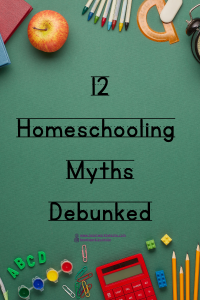This post may contain affiliate links, which means we may receive a commission, at no extra cost to you, if you make a purchase through a link. Please see our full disclosure on the Affiliate Disclosure Page.

Homeschooling myths abound in the education community. There are so many things that non-homeschoolers don’t understand, when looking in from the outside.
In today’s world, many things are going on in the public school system, so many issues that teachers and students have daily.
As parents, we must make a decision as to what is best for our children. We have to determine if they should be left in the public school system or if we should pull them out. Parents have a few alternatives available when it comes to their child’s education. One option is to allow their child to attend a private school. However, that can be prohibitively expensive for some families. Another option is homeschooling, although there are a lot of myths about what that entails.
Before we start debunking the homeschool myths, let me share my family’s story.
Our Homeschool Story
My husband and I have one daughter. From kindergarten until 4th grade, she attended public school. In 5th grade, she attended a brand new public charter school. (That’s a different story for a different day.)
We moved her back to the public middle school in our district for 6th-8th grades. However, she was bullied to the point that she didn’t want to go to school anymore. She completed 8th grade, and that summer, as a family, we decided that we were going to homeschool for high school.
My husband works 40-60 hours a week. At the time, our daughter was in 9th grade and I was working as a substitute teacher, but I had a couple of long-term assignments that had me working every day for 2-3 months at a time.
During her 10th-grade year, I was hired as a full-time English teacher at a local high school. I worked every day the entire school year.
During her last 2 years of high school, she was enrolled in the local community college. She had to do the work online (because of the pandemic) but earned her Associate of Arts degree before graduating from high school.
Homeschool Myths
Myth #1–Homeschooling is only for religious or faith-based families.
 Although there are a lot of families who homeschool for religious reasons, many of us chose homeschooling for other reasons. For example, we chose it so that our daughter wouldn’t be bullied by the same people at school for 4 more years.
Although there are a lot of families who homeschool for religious reasons, many of us chose homeschooling for other reasons. For example, we chose it so that our daughter wouldn’t be bullied by the same people at school for 4 more years.
There are many faith-based and secular resources available to homeschooling families today. Parents have the option to choose if they want to use religious or non-religious materials in their homes.
Myth #2–Homeschoolers do not socialize.
When I hear this, I laugh. Homeschool students have a lot more freedom and flexibility with their schedules.
When my daughter was in high school, she was part of a youth bowling league, and she was on the NC All-Star team and our local bowling alley’s travel team.
She was also a member of Girl Scouts USA (earned her Gold Award), was part of Scouts BSA (Boys Scouts of America), and was only a few requirements from being a Star Scout (just below Eagle) when she aged out.
We did more things, something almost every night, when she was homeschooled that we would never have had the time to do if she had been in public school. She would have had homework to complete at night, and would not have had the opportunities to do the extra things.
Myth #3–Homeschoolers just play video games all day.
 While there are some curriculums that are built around playing games on the computer to learn, most homeschool students are not playing games all day.
While there are some curriculums that are built around playing games on the computer to learn, most homeschool students are not playing games all day.
Some students don’t use the computer for their work unless they need to look something up. Others complete all of their work online.
Myth #4–Parents aren’t qualified to teach.
Although I am a licensed high school English teacher, I know my limits. I could not teach math or science. I also could not teach art.
So even though I could not teach those subjects, I found a curriculum for each that our daughter could use. They came with answers and explanations.
But, parents teach even when we aren’t trying. We teach our children every day, but we don’t make a lesson plan to do it.
If you get the curriculum that teaches your child for you, and you still don’t feel qualified, you can always hire a tutor (like a local high school student who needs a little cash) or find a co-op near you that is teaching the subject.
Myth #5–Homeschoolers can’t play sports or do extracurricular activities.
 One thing most homeschool parents don’t know is that there are some rules and allowances in place for homeschooled students to be able to participate in sports and clubs at public schools. The parents have to check with the local school system (or private schools) to see if it is possible in their area.
One thing most homeschool parents don’t know is that there are some rules and allowances in place for homeschooled students to be able to participate in sports and clubs at public schools. The parents have to check with the local school system (or private schools) to see if it is possible in their area.
However, there are many areas that have sports, clubs, and groups specifically for homeschoolers. Parents can check online, and in Facebook groups for their hometowns, for information about these activities.
Again, homeschooled students have more flexible schedules, so they may be able to do things at different times than students who are in classes in public schools all day.
Myth #6–Parents are stay-at-home moms who don’t work.
As I shared earlier, I worked almost full-time or full-time while we homeschooled our daughter.
Some families have stay-at-home moms or dads, but that is their choice. Other families have parents who work opposite schedules so that one can be at home with the child(ren) all the time. Now, there are a lot of parents who are able to work at home, and they can work while their children are completing their schoolwork.
It is not impossible to homeschool a child if you are working, but you have to have a plan in place to make it successful.
Myth #7–All homeschooled students are gifted.
 As with public schools, there are some gifted students, some on-level students, and some struggling students. Homeschooling is no different.
As with public schools, there are some gifted students, some on-level students, and some struggling students. Homeschooling is no different.
Some students are able to excel because of the freedoms that homeschooling allows, but students who are struggling are not left behind. They are able to work at their own pace and do not have to try to keep up with what the rest of the class is doing.
Myth #8–Homeschoolers do not go to college.
This is not true at all. Many colleges readily accept homeschooled students because they are more capable of working through difficulties on their own. They typically advocate for themselves in their education because they know what they need.
Parents and students just need to check with the colleges in which they are interested to find out what is needed for admission to the school.
In most places, community colleges and 4-year schools have programs for homeschooled students to take college classes while they are in high school. Many times, these programs are free or very inexpensive.
As I said, my daughter completed her Associate of Arts degree in 2 years online through our local community college.
Myth #9–All homeschool families are alike.
 Homeschooling families are as diverse as public schooling families.
Homeschooling families are as diverse as public schooling families.
Some have multiple children, but others have one child, like me. There are some religious families who homeschool, but there are also secular homeschooling families.
I would say that no 2 homeschooling families are exactly alike. There are so many options for things when it comes to homeschooling that it would be hard for families to be alike.
Myth #10–Families are anti-public schools.
My husband and I are both products of public schools. I am a licensed public high school teacher. Our daughter attended public school through 8th grade.
We are not anti-public schools. We love being able to support teachers who are in public classrooms.
Myth #11–Only wealthy families can homeschool.
 With so many resources available for homeschooling, just about any family can do it. There are free, inexpensive, and expensive resources available. Knowing this, a family could homeschool for very little financial cost for the year.
With so many resources available for homeschooling, just about any family can do it. There are free, inexpensive, and expensive resources available. Knowing this, a family could homeschool for very little financial cost for the year.
Families can find things to use to homeschool that will fit into their budgets. This helps to allow almost any family the ability to homeschool their children.
Myth #12–There must be a room in the home to use as a classroom.
Honestly, our daughter used the dining room table most of the time. She did use her desk sometimes. There were also times that she worked in her bedroom or on the couch. However, she was in high school.
I think that for younger students, it would be easier to have a dedicated area for working. Set up a specific place for supplies to be housed, but this does not have to be the only area in the home where students do work though.
Homeschooled students can work in the backyard or at the park. They can work just about anywhere. There is no classroom required.
If you don’t have a room in your house that you can turn into a classroom, don’t let that stop you. Students learn better when they are comfortable anyways.
Conclusion
I am so glad that we were blessed to be able to homeschool our daughter for high school. She was able to do so many things that she wouldn’t have been able to do if we had decided to leave her in the public high school.
Many times, parents use information, like these myths to determine if they will homeschool their children or not.
My hope is that you will be able to use the information provided here to make a more educated decision about whether to homeschool your children or not.
If you have questions, please don’t hesitate to leave them in the comments.
I will try to answer anything I can. I’m sure there are other homeschooling parents who either have the same question or who can help to answer them.
